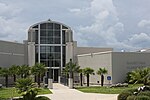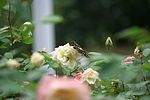The Samuel P. Harn Museum of Art is an art museum at the University of Florida in Gainesville, Florida. It is in the UF Cultural Plaza area in the southwest part of campus.
The Harn is a 112,800-square-foot facility, making it one of the largest university art museums in the South. This includes 40,400 square feet of exhibition space, 5 garden spaces, a 250-seat auditorium, a museum store, a study center, a café, and classroom spaces. The museum has a permanent collection and an array of temporary exhibitions. The Harn's permanent collection totals more than 11,300 objects, which are focused on Asian, African, modern and contemporary art, as well as photography. The museum sponsors international and Florida-centric exhibitions. The university sponsors educational programs at the museum including films, lectures, interactive activities, and school and family offerings.
In October 2005, the Harn expanded by more than 18,000 square feet (1,700 m2) with the opening of the Mary Ann Harn Cofrin Pavilion, which includes new educational and meeting areas and the Camellia Court Cafe, the first eatery for visitors of the Cultural Plaza.
In August 2021, it was announced that it would be expanding with a new wing of 20,000 square-feet.The museum is accredited by the American Alliance of Museums. UF offers a virtual tour for prospective visitors.












